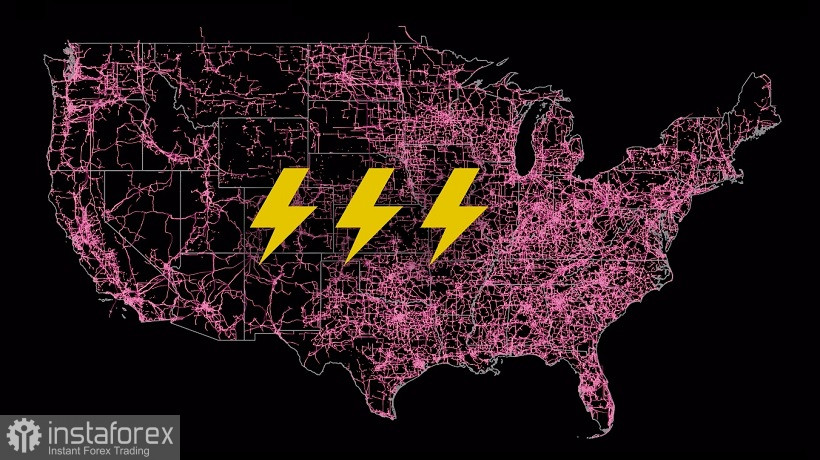The euro-dollar pair is declining for the third consecutive trading day. On Friday, EUR/USD bulls came close to the resistance level of 1.0770 (the lower boundary of the Kumo cloud on the D1 timeframe), but failed to overcome this target. After the release of the Non Farm Payrolls report, the bears seized the initiative and have been holding their grip since then: the pair is gradually sliding towards the support level of 1.0620 (the middle line of the Bollinger Bands indicator on the same timeframe). US President Joe Biden also added fuel to the fire, who just introduced a state of emergency in the United States. If traders push through the above price barrier, they will open their way to the area of the 5th figure, significantly strengthening the bearish sentiment for the pair.

The decline in EUR/USD is primarily due to the general strengthening of the US currency. The US dollar index has been growing for the third day, gradually regaining lost positions. Today, it updated the two-week high, returning to the area of the 102nd figure. The dollar index follows the oil market, which has resumed its growth again. In particular, a barrel of Brent crude oil has already tested the $120 mark today. Let me remind you that last week OPEC+ representatives decided to increase oil production quotas by 648,000 barrels per day (in July and August) instead of the previously planned increase by 432,000 b/d. The oil market plunged somewhat after this decision was announced, but recovered quickly enough. Oil traders came to the conclusion that such a step would not reverse the situation as a whole. According to some estimates, in the third quarter, the global oil deficit will average 400,000 barrels per day.
In addition, Saudi Aramco announced that it will raise prices for all grades of exported oil for the countries of Asia, Northwest Europe and the Mediterranean with delivery in July. Thus, Riyadh signaled a shortage of supply. At least the market interpreted this step of the Saudis in this way. Meanwhile, analysts at Goldman Sachs Bank just published a disappointing forecast: they expect the price of oil to continue to rise. In their opinion, Brent will rise to $140 per barrel in the third quarter amid a decrease in supply and a recovery in energy demand in China.
The general nervousness of traders intensified yesterday and after the announcement of an emergency situation in the United States due to a potential shortage of electricity generating capacity. Biden's decree states that the emergency regime is being introduced due to the global energy crisis amid extreme weather conditions in the US. Drought and high temperatures have a negative impact on generation and at the same time increase the demand for electricity. The US president also announced a shortage of solar modules, in connection with which he exempted from duties the import of a number of necessary components from Vietnam, Thailand, Cambodia and Malaysia.
Given the growing energy crisis, the growth of the oil market, systemic disruptions in supply chains and geopolitical instability, it can be concluded that inflation will only increase in the foreseeable future, despite the fact that in May the first signs of a slowdown in the growth of the US consumer price index and PCE were noted. The US Federal Reserve, in turn, will be forced to respond to a prolonged increase in inflation by revising its strategy towards tightening. It should be recalled here that at the last meeting, the central bank discussed the idea of a 75-point rate increase, but this initiative did not find support from the majority of Committee members. According to Fed Chairman Jerome Powell, the central bank "did not actively discuss" this proposal. That is, he made it clear that the option itself was not completely rejected – everything will depend on the incoming data.
Therefore, the latest trends, which indirectly indicate a further increase in inflation, support the US currency. In addition, the demand for a safe greenback is also growing amid rising anti-risk sentiment, due to ongoing geopolitical tensions and the growing energy crisis, which is becoming clearer (the emergency regime in the United States is eloquent evidence of this).
But it should be emphasized here that all of the above assumptions that the Fed will resort to more aggressive actions are indirect and hypothetical. None of the Fed members has yet changed their point of view (at least in the public plane) towards a 75-point rate hike in June or July. Therefore, in my opinion, the dollar's current growth is emotional, situational and, accordingly, unreliable. Given this circumstance, it is advisable to go into short positions only after EUR/USD bears overcome the support level of 1.0620 (the middle line of the Bollinger Bands indicator on the daily chart). In this case, the next downward target is the 1.0550 mark – this is the Kijun-sen line on the same timeframe. In any case, longs for the pair look too risky, especially ahead of the European Central Bank's June meeting (Thursday) and the release of data on the growth of the US consumer price index (Friday).





















